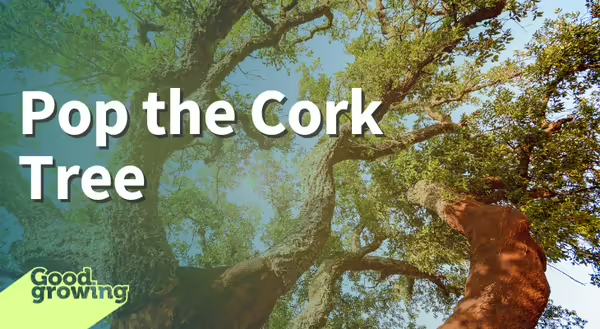
As the holiday season approaches, many of us will indulge in an alcoholic beverage or two as a part of the celebration. My preferences vary depending on the season but during the winter, I strongly favor a bottle of red wine. If you are like me and enjoy the vino, let’s explore one of the plants that contributes to our enjoyment of the beverage in a major way. If you are not a huge fan of wine, read on anyway because this plant product is also used in musical instruments, sports equipment, flooring products, shoes, industrial products, and so much more.
Cork
Natural cork is a component in the bark of many trees. Trees that produce a significant cork layer as a part of the bark are often found in savanna ecosystems where grasslands dominate, and trees are sporadic. During dry seasons, these grasslands have the potential to burn fast and at a high frequency. Trees that are going to survive annual fires need to develop an effective way to insulate the cambium layer of living tissue and cork is the answer.
Cork is a lightweight material that resists decay, is elastic, and is nearly impermeable to air. These characteristics make the material well-suited for stopping bottles of wine. Other uses of cork include as a flooring material, fishing floats, bulletin boards, as the core of baseballs, and as components of the heat shield of spacecrafts.
Cork Oak (Quercus suber)
Quercus suber, or cork oak, is cultivated for the cork developed as part of the tree bark. Native to western Africa and southwest Europe, cork oak grows naturally in forests and open woodlands. This species is tolerant of partial shade and prefers acidic soils that are well-drained. Native to arid climates, cork trees are tolerant of drought. Hardy in plant zones 8-10, cork trees are unable to survive winter conditions in Illinois. In a suitable environment, the cork oak can reach heights of 70-100 feet and an equal spread at maturity.
Many tree species evolved the same thick bark in response to living in ecosystems prone to fire. In the Midwest, Quercus macrocarpa (Bur oak) is native to a tallgrass prairie savanna and has also evolved thick, corky bark as a defense against frequent fires.
How do we get cork?
Commercial production of cork is labor intensive and requires a significant recovery period for the tree post-harvest. Professionals known as extractors use specialized tools and immense skill to harvest tree bark without causing long-term damage to the tree. A single, horizontal cut is made around the circumference of the tree followed by multiple vertical cuts. Sheets of bark are removed from the tree and are known as planks. Cork production is considered a sustainable industry because entire trees are not harvested, only part of the tree is collected leaving the specimen to live and grow.
Trees are cultivated on plantations and kept in production until reaching the age of 125 years, although they are capable of living for more than 200 years. The first harvest rarely occurs before a tree reaches thirty years of age and two feet in circumference. Cork collected during the first harvest is of lower quality than subsequent harvests and is referred to as ‘virgin cork’. Once a cork harvest is complete, trees are allowed to recover for nearly a decade before being able to produce another cork harvest.
Portugal produces approximately 50% of the world’s cork harvest each year. Most of the annual cork production is used in products other than wine bottle stops. Only about 15% of cork is used in the wine industry but it accounts for approximately 65% of industry revenue.
Good Growing Fact of the Week: The Whistler’s Tree or Sobreiro Monumental in Aguas de Moura, Portugal is known as the largest production cork tree. The tree was planted in 1783 and has produced over 20 cork harvests. The largest single harvest produced 2646 pounds of raw cork, enough to make 100,000 wine bottle stoppers.
Sign up for our emails! Want to get notified when new Good Growing posts are available? SIGN ME UP
MEET THE AUTHOR
Emily Swihart is a Horticulture Educator with the University of Illinois Extension, serving Henry, Mercer, Rock Island, and Stark counties since 2021. Emily provides horticulture programming with an emphasis on trees, native vegetation, and home landscape design.